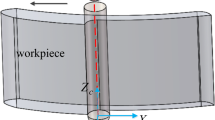Abstract
This paper proposes a new method of automatic detection and elimination of cutter gouging when using the fillet-end milling cutter to produce a complex surface on the five-axis computer numerical control machine tool. To avoid local cutter gouging at the point where the cutter and part surface make contact with each other, the method of exact curvature matching between the cutter and part surface is presented. The size of cutter radii is more easily determined by this method. To detect if a rear cutter gouging occurs near the contact point, a square grid with horizontal and vertical points is used for illustrating the checking area and checking points. The technique of automatic generation of the square grid points and the method of detection and avoidance of rear cutter gouging are investigated throughout this article. In the end, the studied methodology and algorithms are inspected and verified by using an example of nonuniform rational B spline surface.
Similar content being viewed by others
References
Kim BH, Chu CN (1994) Effect of cutter mark on surface roughness and scallop height in sculptured surface machining. Comput Aided Des 26(3):179–188
Yoon JH (2005) Fast toolpath generation by the iso-scallop height method for ball-end milling of sculptured surfaces. Int J Prod Res 43(23):4989–4998
Yoon JH (2007) Two-dimensional representation of machining geometry and tool path generation for ball-end milling of sculptured surfaces. Int J Prod Res 45(14):3151–3164
Li H, Feng HY (2004) An efficient five-axis machining of free-form surfaces with constant scallop height tool paths. Int J Prod Res 42(12):2403–2417
Than L, Jae-Woo L, Erik LJ, Bohez (2009) A new accurate curvature matching and optimal tool based five-axis machining algorithm. J Mech Sci Technol 23(10):2624–2634
Guillaume F, Gerard P (2010) Modeling of interferences during threads milling operation. Int J Adv Manuf Technol 49(1–4):41–51
Cha-Soo S, Kyungduck C, Yuan-Shin L (2003) Optimizing tool orientation for 5-axis machining by configuration-space search method. Computer-Aided Des 35(6):549–566
Chu CH, Chen GT (2006) Tool path planning for five-axis flank milling with developable surface approximation. Int J Adv Manuf Technol 29(7–8):707–713
Rao A, Sarma R (2000) On local gouging in five-axis sculptured surface machining using flat-end tools. Computer-Aided Des 32(7):409–420
Mohammad JBF, Feng HY (2009) Effect of tool tilt angle on machining strip width in five-axis flat-end milling of free-form surfaces. Int J Adv Manuf Technol 44(3–4):211–222
Yu W, Tang XW (1999) Five-axis NC machining of sculptured surfaces. Int J Adv Manuf Technol 15(1):7–14
Mullins SH, Jensen CG, Anderson DC (1993) Scallop elimination based on precise five-axis tool placement, orientation, and step-over calculations. ASME Adv Des Autom 65(2):535–544
Jensen CG, Anderson DC (1992) Accurate tool placement and orientation for finish surface machining. ASME Concurr Eng 59:127–145
Jensen CG, Mulkay EL, Simpson TS (1995) A practical implementation of curvature matched machining for complex geometric objects. ASME Concurr Prod Process Eng 85:1–14
Lee YS, Ji H (1997) Surface interrogation and machining strip evaluation for 5-axis CNC die and mold machining. Int J Prod Res 35(1):225–252
Lee YS, Chang TC (1996) Automatic cutter selection for five-axis sculptured surface machining. Int J Prod Res 34(4):977–998
Chen LG, Cheng JW, Wang YZ (2008) Tool path generation argorithm for five-axis NC machining with a toroidal cutter. Chin J Mech Eng 44(3):205–212
Lee YS (1997) Admissible tool orientation control of gouging avoidance for 5-axis complex surface machining. Computer-Aided Des 29(7):507–521
Wu BH, Luo M, Zhang Y, Li S, Zhang DH (2008) Advances in tool path planning techniques for 5-axis machining of sculptured surfaces. Chin J Mech Eng 44(10):9–18
Hosseinkhani Y, Akbari J, Vafaeesefat A (2007) Penetration-elimination method for five-axis CNC machining of sculptured surfaces. Int J Mach Tool Manuf 47(10):1625–1635
Jensen CG, Red WE, Pi J (2002) Tool selection for five-axis curvature matched machining. Comput-Aided Des 34(3):251–266
Zhong JL, Mi NS, Yu YD (1999) Research on algorithm of automatic generation of interference-free cutter location path for NC machining of freeform surfaces with flat-end cutters. Chin J Mech Eng 35(6):93–97
Chen LW, Ceng JJ, Li GW (2000) Tool path interference elimination algorithm of sculptured surfaces. J Southeast Univ 30(6):44–47, Natural Science Edition
Ahmet C, Ali U (2010) A novel iso-scallop tool-path generation for efficient five-axis machining of free-form surfaces. Int J Adv Manuf Technol 51(9–12):1083–1098
Jensen CG, Anderson DC (1993) Accurate tool placement and orientation for finish surface machining. J Des Manuf 3(4):251–261
Chiou CJ, Lee YS (2005) Optimal tool orientation for five-axis tool-end machining by swept envelope approach. ASME J Manuf Sci Eng 127(4):810–818
Anotaipaiboon W, Makhanov SS (2005) Tool path generation for five-axis NC machining using adaptive space-filling curves. Int J Prod Res 43(8):1643–1665
Author information
Authors and Affiliations
Corresponding author
Rights and permissions
About this article
Cite this article
Du, J., Yan, Xg. & Tian, Xt. The avoidance of cutter gouging in five-axis machining with a fillet-end milling cutter. Int J Adv Manuf Technol 62, 89–97 (2012). https://doi.org/10.1007/s00170-011-3779-3
Received:
Accepted:
Published:
Issue Date:
DOI: https://doi.org/10.1007/s00170-011-3779-3



